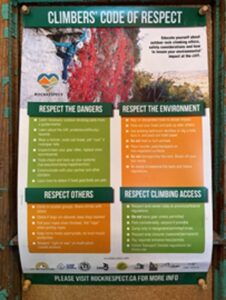By Jenny Feick, PhD
I recalled the old GDTA Trail Users Code while listening to the Her Odyssey duo when Lani Smith, my husband Ian Hatter and I met them for lunch at Truffle Pigs in Field on a clear sunny September day in 2021. Bethany Hughes and Lauren Reed entertained us with the tales of their adventures going SOBO on the GDT from Kakwa to Field. We agreed to meet them again at Interlakes Campground in Peter Lougheed Provincial Park. From there, they would backpack on to Waterton Lakes National Park. They expressed astonishment about how ill-prepared some thru-hikers seemed and concerned about how much garbage and still-burning campfires were being left behind by some of the hikers on the GDT. They said they were trying to educate people on the no-trace camping concept through some of their blogs on the Her Odyssey website. They suggested that the GDTA set more accurate expectations about the condition of the trail and how to prepare for the challenges and instill backcountry ethics in their clientele. When they gave their talk at the GDTA’s AGM later that month, they made similar points.
So, last fall, I thought I should dig out the old trail user’s code that the first iteration of the GDTA (from the mid-1970s to late 1980s) developed. It was near and dear to my heart. The promotion of the Great Divide Trail User’s Code was something that Dave Higgins and I fostered, having been Bruce Trail Association members in Ontario before we moved to Alberta in 1973/74, and thus familiar with the BTA’s Trail User’s Code.
At first, I thought the Code might be in Tales from the Great Divide. Interestingly enough, no one interviewed for that book specifically mentioned it, although they did talk at length about the GDTA’s policy paper where the code was first published in 1975.

In that report, entitled the Great Divide Trail: Banff to Waterton, Its Concept and Future, on pages 9-10, it stated that the fifth aim of the GDTA was “to encourage proper wilderness etiquette through the Trail User’s Codes, newsletters and other publications.” It then presented the Great Divide Trail User’s Code.
The Great Divide Trail User’s Code
- Travel only along marked routes.
- Carry out all garbage (if you can carry it in full, you can carry it out empty!)
- Do not disturb wildlife. Even approaching with a camera can constitute harassment.
- Do not damage vegetation. Be especially careful with the fragile plants of the alpine and sub-alpine zone, and never cut green trees or boughs.
- Do not graze horses in alpine areas. Avoid camping above treeline.
- Light cooking fires at official campsites only and in designated sites. Drench fires after use (better still, carry a light-weight hikers’ stove).
- Leave campsites tidier than the way you found them.
- Clear the trail of obstructions (windfall) when possible and desirable.
- Travel in small groups: large parties cause excessive disturbance, and travelling alone can be hazardous.
- Travel for pleasure —not to establish records.
- Leave only your thanks and take nothing but photographs.
I checked online and discovered that the BTA Trail User’s Code is still used today, and there is also a Pacific Crest Trail Association Volunteer Code of Conduct. Trails BC posts “A Trail User’s Code of Ethics” and Alberta TrailNet promotes its Trail Etiquette/Respect the Land. There is a Thru-Hikers Code of Conduct, and even a Climbers Code of Respect (see below).
Over the winter, I corresponded with Doug Borthwick, Brad Vaillancourt, Joan Pendleton, and Deb Yanchula. They agreed there would be merit in resurrecting the old GDTA Trail User’s Code, still mostly applicable at 47-years old, and updating it to suit the GDT experience in the 2020s. Over the past 50 years, changes in technology, visitation, park agency regulations, and required permits need to be reflected and some formalizing of “Leave No Trace” principles would be useful to incorporate as well. Trail Angel etiquette may also be worth including.
So, I agreed to coordinate putting a draft revised GDTA’s Trail User’s Code together for consideration by the GDTA. I am thus interested in suggestions from individuals reading this issue of The Pathfinder, especially those who have been on the trail in the past decade, either travelling or working, on the updates you think need to be made to contemporize the old GDTA’s Trail User’s Code. Please send your ideas and any recommended wording to me at jenny.feick@gmail.com with the subject line “Suggestions for a New GDTA Trail User’s Code”. Keep in mind that we are striving for a clear, concise, simple and effective code of conduct. Thank you!

